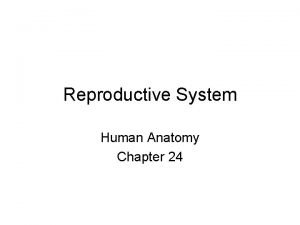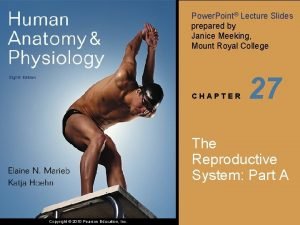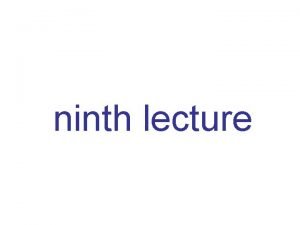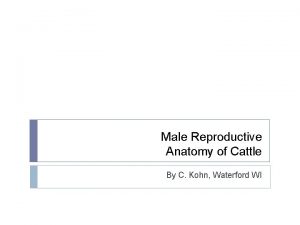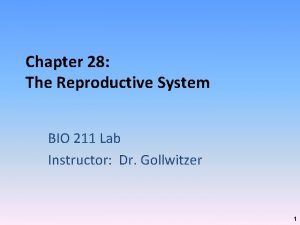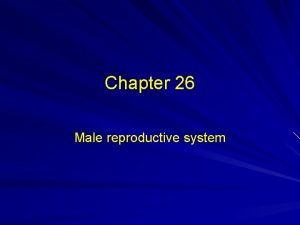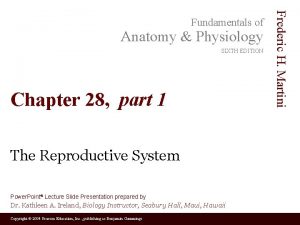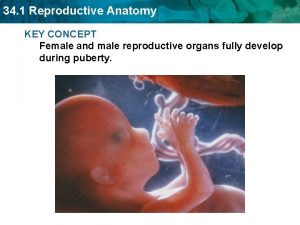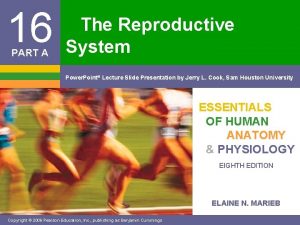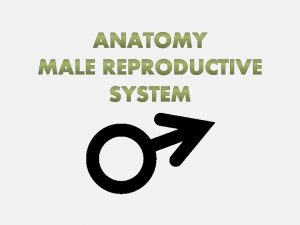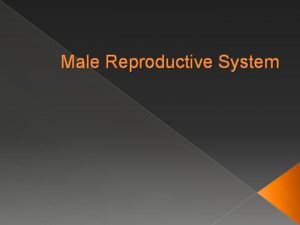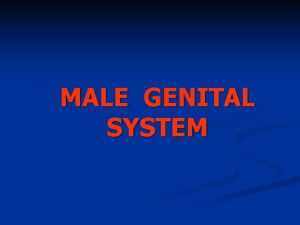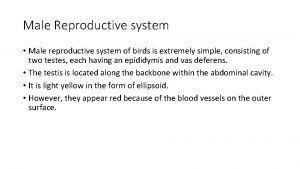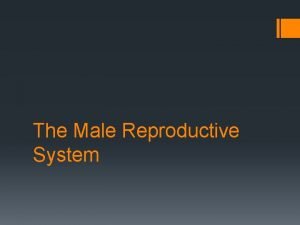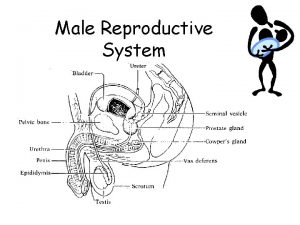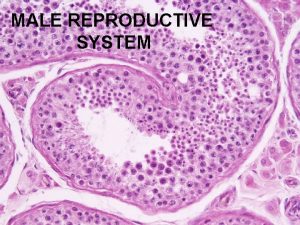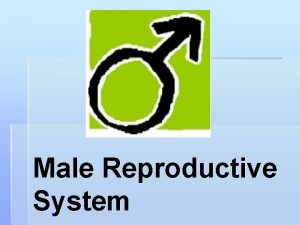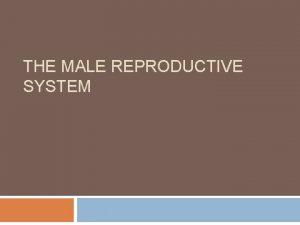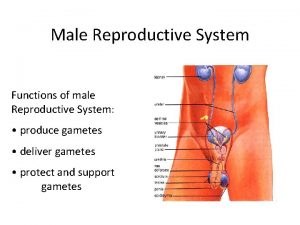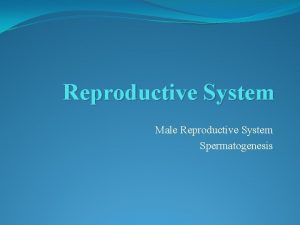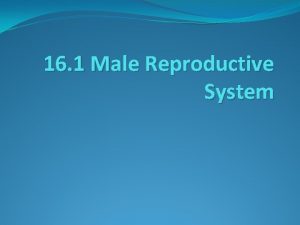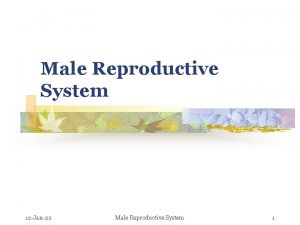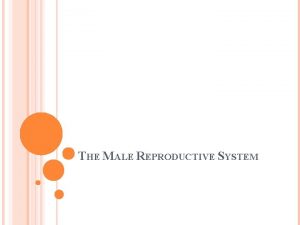Male Reproductive System Essential reproductive organs for men




























- Slides: 28

Male Reproductive System -- Essential reproductive organs for men & women are called: Gonads -- in men, the gonads are the: -- suspended outside the body cavity Testes Scrotum

--the testes are surrounded by a membrane called the: --this membrane also enters into the testes to form lobules which contains: -- this is where sperm is produced Seminiferous tubules Interstitial cells Septum -- within the septums that separates the lobules are cells called: Tunica Albuginea --Testosterone is produced here.

Accessory Reproductive Ducts in Males Seminal Vesicles Spermatic Cord Ejaculatory duct Urethra Ductus (Vas) Deferens Epididymis

Accessory Sex Glands Seminal Vesicles -- contributes 60% of the seminal fluid (rich in Fructose)

Accessory Sex Glands Prostate gland -- provides 30% of the fluid & fluid is alkaline -- it also activates the sperm -- can enlarge in older males making it difficult to urinate (Benign Prostatic Hypertrophy)

Accessory Sex Glands -- Makes up less than 5% of the fluid -- mucus-like & lubricate end of urethra Bulbourethral (Cowper's) Gland

Other Accessory Structure of the Male Reproductive System Rectum Urinary Bladder Glans Penis Anus Foreskin (Prepuce) Scrotum

Functions: Testosterone 1. Needed for normal development & functioning of the primary sex organs 2. Necessary for the maturation of sperm 3. Development & maintenance of the secondary sex characteristics a. growth of body hair b. voice change c. greater muscle strength

Testosterone Side Effects: 1. Sweat & oil glands become more active -- cause acne & body odor 2. Baldness 3. Responsible for the sex drive & may contribute to aggressiveness in males

SPERMATOGENESIS 46 STEM CELL (Spermatogonia) PRIMARY SPERMATOCYTE 46 46

PRIMARY SPERMATOCYTE 46 SECONDARY SPERMATOCYTE 23 23 SPERMATID 23 SPERM 23 23 23

Sperm -- One of the smallest Acrosome & most highly specialized cell in the body Nucleus -- Responsible for all Head Midpiece the characteristics a baby inherits from the father Mitochondria -- Another name for tail is: Flagellum Tail

Female Reproductive System The essential organs (gonads) for the female are the: Ovaries Accessory Organs --also called Uterine tubes or Oviducts Fallopian tubes Ovaries

Accessory Organs Fallopian Fimbriae tubes Ovaries --the fringe-like structures at the end of the tubes are called: -- the fallopian tubes open into the abdomen (do not attach to the ovary)

Accessory Organs (cont. ) Fundus -- is almost all Uterus Cervix muscle called: Myometrium -- contain deep folds that allow for -- upper part of the expansion called: uterus in which the Rugae fallopian tubes -- inner lining of the uterus attach is the: is called: -- lower section of the Endometrium uterus is the:

Accessory Organs (cont. ) -- also contain rugae -- mainly composed of muscle -- lined with mucus membranes -- attached to the uterus & opens to the outside Vagina -- p. H is slightly acidic to protect it from bacteria

Accessory Sex Glands 1. Breasts -- size is determined by amount of fat -- each breast is divided into 15 – 20 lobes, which further divide into many lobules -- each lobule contains milksecreting glands called: Nipple (these glandular cells are arranged in grape-like clusters called: Alveoli Lactiferous glands

Accessory Sex Glands (cont. ) 1. Breasts --drain the alveoli in the direction of the nipple -- colored area of the nipple is the: Areola Nipple Lactiferous duct Lactiferous glands

After pregnancy, the glands in the breasts are stimulated to produce milk by the hormone: Prolactin What hormone causes the breast to release that milk? Oxytocin Name the fluid that's produced by the breast Colostrum prior to milk? Why is it important? Contains antibodies

Accessory Sex Glands (cont. ) 2. Greater Vestibular Glands -- also called: -- opens into the vestibule (space between the labia minora & the vaginal opening) Bartholin gland -- secretes a mucus-like lubricating fluid for the vagina

External Genitals or Vulva Mons pubis Labia Majora Labia Minora Clitoris Urethral orifice Hymen Vaginal orifice Anus Clitoris Labia Minora Labia Majora

Ovary -- Weigh about 3 Grams -- At birth, each female -- at puberty, this number is reduced to 400, 000 has about 2 million primary follicles Ovarian Follicles & each follicle contains -- only 350 to 500 of these an Oocyte will develop into a mature Corpus Luteum follicle Fertilization Ovary of the Ovum Mature (Graafian) Follicle

46 23 Primary oocyte Polar 23 Body 23 23 23 Secondary oocyte

23 23 Secondary oocyte EGG

Production of Estrogen --causes the development & maintenance of the female secondary sex characteristics 1. causes appearance of pubic hair & breast development 2. responsible for the female body shape --causes the start of the menstrual cycle

Production of Progesterone -- produced by the Corpus Luteum 1. develops from the ruptured follicle after ovulation 2. stimulated by LH (Lutenizing Hormone) -- produced for 11 days after ovulation -- stimulates further development of the endometrial lining

Menstrual Cycle -- Usually about -- has 3 phases: 28 days 1. Menstrual Phase (Menses or Menstruation) --first 4 to 5 days --endometrial lining sloughs off 2. Postmenstrual (Follicular) Phase --between the end of menses & ovulation --around day 6 to 13 --also called Proliferation phase --endometrium thickens & becomes vascular

(Ovulation occurs around day 14) 3. Premenstrual (Luteal) Phase --around days 15 to 28 --further thickening of the endometrium
 Mesovariun
Mesovariun Function of the vagina
Function of the vagina Examination of reproductive system
Examination of reproductive system Development of female reproductive system
Development of female reproductive system Exercise 42 anatomy of the reproductive system
Exercise 42 anatomy of the reproductive system Oogenesis diagram
Oogenesis diagram Copyright
Copyright Parts of male and female reproductive system
Parts of male and female reproductive system Male reproductive system diagram
Male reproductive system diagram Luteinizing hormone in male reproductive system
Luteinizing hormone in male reproductive system Reproduction in human
Reproduction in human Art-labeling activity: the male reproductive system, part 1
Art-labeling activity: the male reproductive system, part 1 Male reproductive system information
Male reproductive system information Male reproductive system produces sperm cells
Male reproductive system produces sperm cells Bull reproductive system parts and functions
Bull reproductive system parts and functions Prostate glands
Prostate glands Examples of asexual reproduction
Examples of asexual reproduction Function of male reproductive system
Function of male reproductive system Cartilaginous fish reproduction
Cartilaginous fish reproduction Pila reproduction
Pila reproduction Bladder fetal pig
Bladder fetal pig Female part of a flower
Female part of a flower Figure 28-1 the male reproductive system
Figure 28-1 the male reproductive system Primary sex organ of the male reproductive system? *
Primary sex organ of the male reproductive system? * Chapter 20 reproduction and pregnancy
Chapter 20 reproduction and pregnancy Cow male reproductive system
Cow male reproductive system Pearson
Pearson Colon function in male reproductive system
Colon function in male reproductive system Figure 16-1 male reproductive system
Figure 16-1 male reproductive system
